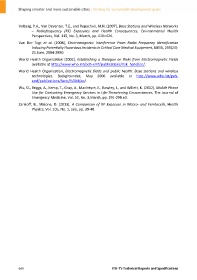Page 650 - Shaping smarter and more sustainable cities - Striving for sustainable development goals
P. 650
Valberg, P.A., Van Deventer, T.E., and Repacholi, M.H. (2007), Base Stations and Wireless Networks
– Radiofrequency (RF) Exposures and Health Consequences, Environmental Health
Perspectives, Vol. 115, No. 3, March, pp. 416–424.
Van Der Togt et al. (2008), Electromagnetic Interference From Radio Frequency Identification
Inducing Potentially Hazardous Incidents in Critical Care Medical Equipment, JAMA, 299(24):
25 June, 2884‐2890.
World Health Organization (2002), Establishing a Dialogue on Risks from Electromagnetic Fields
available at http://www.who.int/peh‐emf/publications/risk_hand/en/.
World Health Organization, Electromagnetic fields and public health: Base stations and wireless
technologies, Backgrounder, May 2006 available at http://www.who.int/peh‐
emf/publications/facts/fs304/en/.
Wu, O., Briggs, A., Kemp, T., Gray, A., Macintyre, K., Rowley, J., and Willett, K. (2012), Mobile Phone
Use for Contacting Emergency Services in Life‐Threatening Circumstances, The Journal of
Emergency Medicine, Vol. 52, No. 3,March, pp. 291‐298.e3.
Zarikoff, B., Malone, D. (2013), A Comparison of RF Exposure in Macro‐ and Femtocells, Health
Physics, Vol. 105, No. 1, July, pp. 39‐48.
640 ITU‐T's Technical Reports and Specifications

